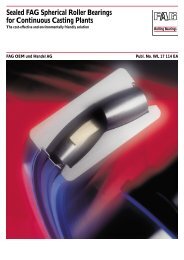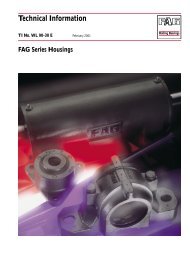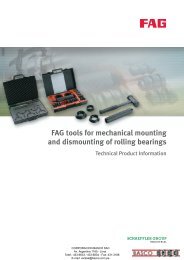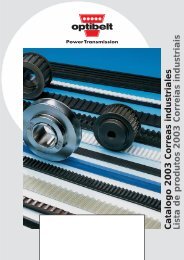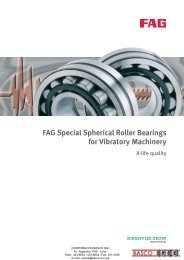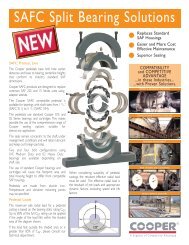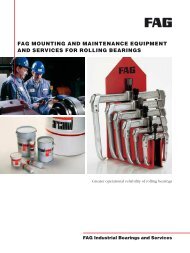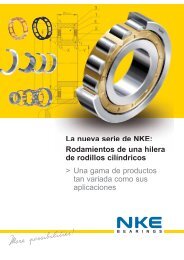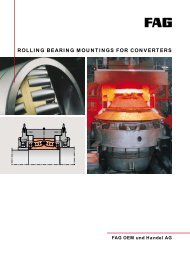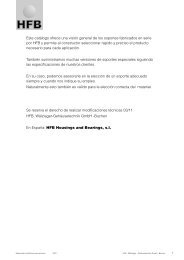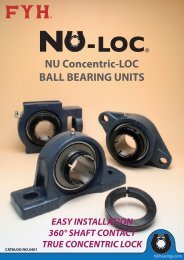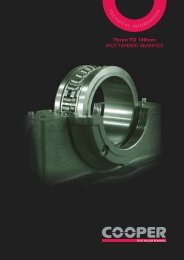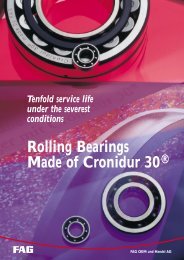Create successful ePaper yourself
Turn your PDF publications into a flip-book with our unique Google optimized e-Paper software.
32–33 Automotive gearboxes<strong>Design</strong><strong>The</strong> rolling bearings used in torque converters in vehicles(manual transmissions and transfer boxes) are custom-tailoredto this application. Depending on theload accommodation and speed requirements, deepgroove ball bearings – both unshielded and dirt-protected("clean bearings") –, cylindrical roller bearings,combined bearings and tapered roller bearings haveproven themselves in the main bearing locations. <strong>The</strong>idlers are generally supported on needle roller and cageassemblies. <strong>The</strong> main bearing locations have locatingfloatingbearing designs, adjusted bearing or floatingbearing arrangements.Locating-floating bearing arrangementRadial loads are accommodated by both bearings whilethe axial load is taken up by the locating bearing. Withextreme axial loads the radial and axial loads may betaken up separately (axial bearing e. g. deep groove ballbearing or four-point bearing) at the locating bearingend.Adjusted bearing arrangement<strong>The</strong> angular contact ball bearings or tapered rollerbearings are mounted in opposition to one another.<strong>The</strong> bearings, when running at operating temperature,should have zero clearance or even preload (narrowaxial guidance). Regulation <strong>of</strong> the axial clearance byaxial displacement <strong>of</strong> the bearing rings. Both bearingsaccommodate radial and axial loads.Floating bearing arrangement<strong>The</strong> bearings (except for angular contact bearings, allbearing types may be used) accommodate both radialand axial loads, permitting, however, axial displacement<strong>of</strong> the shaft. This axial displaceability is such thatthe bearings are never preloaded, not even under adversethermal conditions.Lubrication<strong>The</strong> gear wheels <strong>of</strong> vehicle transmissions are all oil-lubricatedalmost without exception. For this reason oillubrication is usually also provided for the rolling bearingsin the transmission.Since the rolling bearings require only very little lubricant,the oil splashed from the gear wheels is normallysufficient for bearing lubrication. Only in cases wherethe splash oil does not reach the bearings may it benecessary to provide collecting pockets and feed ducts.On the other hand it is advisable to protect those bearingswhich run directly beside the gear wheel from excessiveoil supply, for example by means <strong>of</strong> a seal or abaffle plate.However, with joint lubrication <strong>of</strong> gear wheels andbearings care must be taken that the life-reducing contaminantsare filtered out <strong>of</strong> the oil circulation (costly).Dirt-protected bearingsIn order to keep these contaminants (rubbed-<strong>of</strong>f particlesfrom the gears) out <strong>of</strong> the bearings as long as possible,manual transmissions for cars are fitted todaywith sealed, grease-lubricated deep groove ball bearingsor angular contact ball bearings (so-called dirt-protectedor "clean bearings").Since roller bearings are less affected by cycled particles,the dirt-protected design is not required in automotivegearboxes.<strong>Bearing</strong> selection and dimensioning<strong>The</strong> bearing calculation is based on the maximum inputtorque with the corresponding speed, the gearingdata and the proportionate running times for the individualgear steps.Determination <strong>of</strong> the tooth loadsBased on the tangential load F t = M d / r a radial load(F r = F t · tan E ) and an axial load (F a = F t · tan ) arecalculated. Based on the distances at the individualshafts, the forces acting on the teeth are distributedover the individual bearing locations, also taking intoaccount the tilting moment caused by the tooth loadcomponent F a .Index <strong>of</strong> dynamic stressing f LUnsealed transmission bearings in medium-weight toheavy cars should have an f Lm value <strong>of</strong> 1.0...1.3, whereasthe f Lm value for dirt-protected bearings should be0.7...1.0.<strong>The</strong> bearing loads in the individual speeds and thetransmission bearings are calculated in detail by means<strong>of</strong> computer programs.Attainable life<strong>The</strong> lubricant in open ball bearings must be assumedto be moderately (contamination factor V = 2) to heavilycontaminated (V = 3) .With the usual transmission bearing stress indexes <strong>of</strong>f s* ≈ 2...8, depending on the gear, a cleanliness factor <strong>of</strong>s = 0.6...0.7 is obtained with V = 2, and s = 0.3...0.5with V = 3.Consequently, due to the effects <strong>of</strong> contamination by thetransmission oil, the reserve capacities <strong>of</strong> the unsealedball bearings (higher f Lm value) cannot be utilized. Onthe other hand, if dirt-protected ball bearings are used,FAG 48



